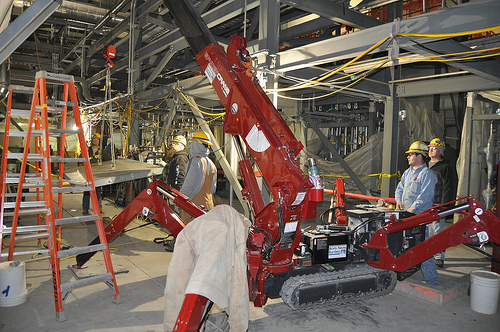Working at height is classed as any type of work that involves using working platforms like scaffolds, spiderlifts and cherry pickers, ladders or step ladders or work that is carried out on a roof or other high level surface. It can be extremely dangerous, which is why it is essential that individuals take every precaution to keep themselves safe. Below we have listed the dos and don’ts of working at height to serve as a reminder.
Do
Plan and Organise Working at Height Tasks
If you have a job that involves working at height, it is essential that the task is properly planned and organised. No work should be carried out without conducting a full risk assessment first.
Ensure your Equipment is Fit for Purpose
When working at height, it is important to make sure that you are using the most appropriate equipment for the job. For example, if you trimming the top of a tree or carrying out construction work on the top floor of a building, a ladder isn’t going to cut it. You will need to hire specialist equipment for working at height, such as a spiderlift.

Carry Out Checks on your Equipment
Before using a piece of equipment to assist you in working at height, it is critically important that you carry out safety checks. You will need to check that the equipment has been set up correctly and that all of its functions are working properly before you use it to carry out your task.
Take Precautions when Working on Fragile Surfaces
If you are working at height and on a fragile surface then you are going to face a number of different safety risks. For this reason, it is essential to take extra precautions and ensure that you are using the right equipment. The best type of working at height equipment to use on fragile surfaces is spiderlifts. They are fairly lightweight and can be spread across a wide base to make them safe and sturdy.
Use Signage
Putting up safety signs to alert other people to the work that is going on can help to prevent accidents. For example, if there is a risk of objects falling from height, you need to make sure that you warn everyone on-site and put up signs around the area as a reminder.
Don’t
Use Equipment if you haven’t been Trained to
In order to use powered access platforms like spiderlifts, you need to have completed a training course and received your IPAF certificate. Do not attempt to use the equipment if you have not been trained to as you could end up causing injury to yourself, as well as those around you. If you are in charge, make sure that you ask to see employees’ IPAF certificates before you allow them to use your spiderlifts.
Compromise on Safety Checks
Even if you have used spiderlifts and other powered access equipment hundreds of times before, you still need to carry out safety checks every time you intend to use a piece of equipment. It’s not worth risking your safety or that of your co-workers.
Work at Height if there’s an Alternative
If there’s an alternative way you can complete the work without having to use powered access platforms and other working at height equipment then do it that way. There are fewer safety risks concerned with working on the ground.
Conclusion
If your job involves working at height, it is important to keep these safety tips in mind at all times. Never carry out the work unless you are 100% confident that you and those around you are safe.







Recent Comments